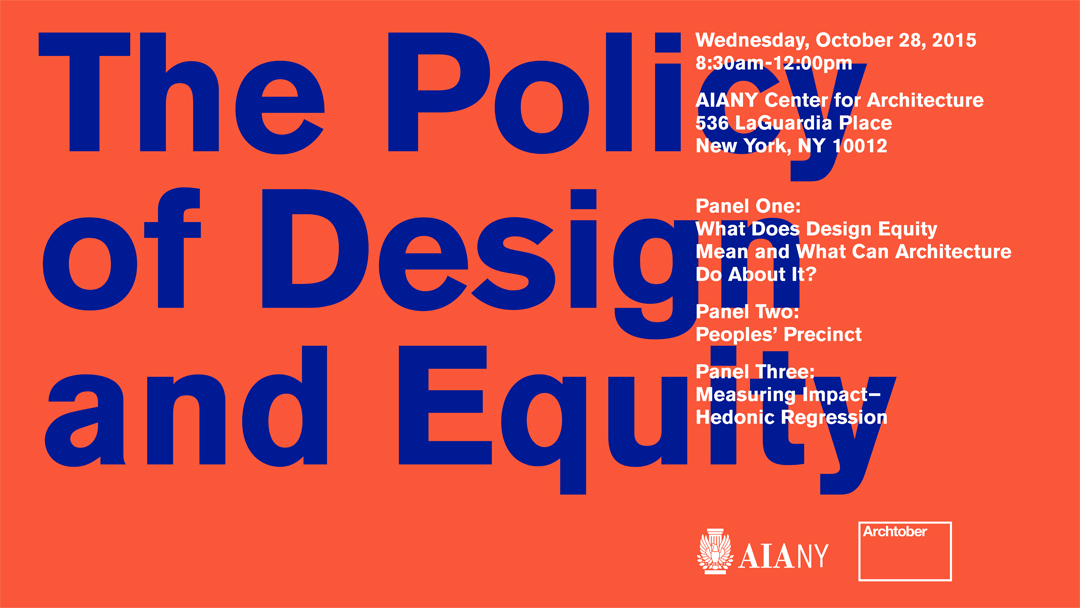
 Department of Design and Construction311
Department of Design and Construction311 Search all NYC.gov websites
Search all NYC.gov websites
October 28, 2015
Town+Gown
The Policy of Design and Equity
In in collaboration with AIANY/Center for Architecture and the AIANY/Public Architecture Committee, in association with Archtober, Architecture and Design Month
This seventh Symposium event in Town+Gown’s ongoing exploration of Design expanded the focus on design to explore what equity and design might mean in the context of contemporary public policy theory and practice. Government is a project owner and client of construction services that implement its capital program, and the public works or capital programs of all levels of government are basically work orders for facilities relating to "social" or "public" goods and to "mixed goods" that correct for negative and positive externalities. Designers play a critical role in designing these social or public goods, with the totality of these publicly-funded spaces performing an equally critical civic function affecting and effected by all members of society.
This event focused on case study projects, including the series of Town+Gown’s design projects in 2014-2015 in connection with New York Police Department’s “People’s Precincts” initiative at the 73 Precinct, located in Brownsville, which consisted of two physical elements: an ATM machine and a community space, located in the space between the front door of the precinct building and the sergeant’s desk, where members of the community and NYPD staff could engage in joint programming. Implementing these two elements would signal a change of policy intent in physical space aimed at improving community police relations. The existing physical facility presented design challenges, and the academic architectural solution consisted of a moveable free-standing modular structure that could be placed somewhere on the sidewalk surrounding the front of the building, which had been constructed in 1985 in the fortress style common to that period.
The academic interior design solution consisted of a redesign of the vestibule, where an ATM had been located, consisting of a simple design, constrained by cost and the physical space limitations at the 73 Precinct, including lighting, signage, furniture and minor interior non-capital renovations of the visitor’s desk, which formed the basis of a broader “civic standard” that could be applied to spaces across NYPD’s inventory of existing buildings. This event also introduced another Town+Gown project to the ongoing Design conversation, which was the creation of a difference-in-difference hedonic model for the City to evaluate the economic impact of its routine public capital improvements in their surrounding neighborhoods, which model was tested on one project—the Great Kills Library renovation in Staten Island. The model, thus determined to be viable for wider application, is available to evaluate the economic impact of the wide variety of routine public projects, with the potential to develop New York City-specific quantitative metrics for capital program planning and enhance understanding of the costs and benefits, with economic impact serving as an initial proxy for equity.
In the first conversation, the panelists from several design fields acknowledged the strong role designers can play to increase societal fairness, especially on public projects, but noted that designers often felt constrained in bringing the full set of design skills to bear on a project by the owner’s requirements since the designer is a consultant to the owner, an important stakeholder on a project, but not the only stakeholder for a project. The idea of working further “upstream” in various processes before specific projects are bid, when an owner’s project definitions are often established and become the constraints under the contractual engagement, surfaced as a strategy for design professionals to begin to use.
The second conversation about the case study Town+Gown design projects for the New York Police Department focused on the use and benefits of participatory and evidence-based design, which architecture and interior design student teams used from the beginning of the design phase on each of the case study projects. Members of the 73 Precinct community attending the event highlighted their appreciation to being included during the design phases. And, finally, in the third conversation showed how quickly quantitative metrics capacity has evolved from economic-based tools to other measures of fairness, revealing the tension that exists between efficiency theory and a societal sense of fairness that changes over time. Click here to see a video of the event.



